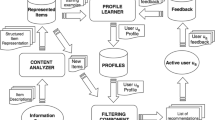Abstract
This paper proposes a collaborative filtering algorithm based on user group interest. A novel co-clustering method (BalClust) and various weighted non-negative matrix factorization algorithms are used in the proposed method. The BalClust method is used to divide the raw rating matrix into clusters, which are smaller than the original matrix. Then, the balance factor is introduced to consider the user weight and the item-based CF (collaborative filtering). To predict the rating of the unknown items in the cluster, the non-negative matrix factorization algorithm was used. The proposed method achieves higher predicting accuracy and efficiency on low dimensional and homogeneous sub-matrices, and the method also reduces the computational complexity by combining the user and item-based CF. Based on the proposed method, this paper proposed an incremental learning method to ensure data accuracy and timeliness to overcome the problem brought by data updates. The experimental results show the proposed methods outperformed traditional CF algorithms, and the completion time is reduced.





Similar content being viewed by others
References
Abrate F, Bona B, Indri M (2013) Multirobot Localization in Highly Symmetrical Environments [J]. J Intell Robot Syst 71(4):403–421
Agarwal D, Merugu S (2007) Predictive discrete latent factor models for large scale dyadic data [C]. In: Berkhin P, ed. Proc. of the SIGKDD. New York: ACM Press, 26–35
Akinshina A, Jambon-Puillet E, Warren PB (2013) Self-consistent field theory for the interactions between keratin intermediate filaments [J]. BMC Biophys 6(9):6–12
Banerjee A, Dhillon I, Ghosh J, Merugu S, Modha DS (2007) A generalized maximum entropy approach to Bregman co-clustering and matrix approximation [J]. J Mach Learn Res 8(8):1919–1986
Bobadilla J, Ortega F, Hernando A (2013) A similarity metric designed to speed up, using hardware, the recommender systems k-nearest neighbors’ algorithm [J]. Knowl-Based Syst 51(6):27–34
Brooks CH, Montanez N (2006) Improved annotation of the blogosphere via auto-tagging and hierarchical clustering [C]. Proceedings of the 15th International Conference on World Wide Web. Edinburgh, UK, 625–632
Brzozowski MJ, Romero DM (2011) Who should I fellow? Recommending people in directed social networks [C]. Proceedings of the 5th International AAAI Conference on Weblogs and Social Media. Barcelona, Spain 458–461
Cheng YZ, Church GM (2000) Biclustering of expression data [C]. In: Bourne PE, ed. Proc. of the 8th Int’l Conf. on Intelligent Systems for Molecular Biology. La Jolla: AAAI Press, 93–103
Cheng G, Wang F, Zhang CS (2009) Collaborative filtering using orthogonal nonnegative matrix tri-factorization [J]. Inf Process Manag 45(3):368–379
Chirici G, Scotti R, Montaghi A (2013) Stochastic gradient boosting classification trees for forest fuel types mapping through airborne laser scanning and IRS LISS-III imagery [J]. Int J Appl Earth Obs Geoinf 25:87–97
Dhillon SI (2001) Co-Clustering documents and words using bipartite spectral graph partitioning [C]. In: Lee D, ed. Proc. of the 7th ACM SIGKDD. New York: ACM Press, 269–274
Dhillon IS, Mallela S, Modha DS (2003) Information-Theoretic co-clustering [C]. In: Getoor L, ed. Proc. of the 9th ACM SIGKDD. New York: ACM Press, 89–98
Dinuzzo F (2013) Learning output kernels for multi-task problems [J]. Neurocomputing 118(2):119–126
George T, Merugu S (2005) A scalable collaborative filtering framework based on co-clustering [C]. In: Raghavan V, ed. Proc. of the 5th IEEE Int’l Conf. on Data Mining. Washington: IEEE Computer Society Press, 625–628
Hai-ling X, Xiao W, Xiao-dong L et al (2009) Comparison Study of Internet Recommendation System [J]. J Softw 20(2):350–362
Badaro G, Hajj H, El-Hajj W, Nachman L (2013) A hybrid approach with collaborative filtering for recommender systems. 2013 9th International Wireless Communications and Mobile Computing Conference (IWCMC), Sardinia, pp 349–354. https://doi.org/10.1109/IWCMC.2013.6583584
Hindle A, Ernst NA, Godfrey MW (2013) Automated topic naming Supporting cross-project analysis of software maintenance activities [J]. Empir Softw Eng 18(6):1125–1155
Kaklauskas A, Zavadskas EK, Seniut M (2013) Recommender System to Analyze Student's Academic Performance [J]. Expert Syst Appl 40(15):6150–6165
Kim H-L, Breslin JG, Decker S, Kim H-G (2011) Mining and representing user interests: The case of tagging practices [J]. IEEE Trans Syst Man Cybern Syst Hum 11(4):683–692
Liu J, Zhang J, Gao Y (2012) Enhancing Spectral Unmixing by Local Neighborhood Weights [J]. IEEE J Sel Top Appl Earth Obs Remote Sens 5(5):1545–1552
Long B, Zhang ZF, Yu PS (2005) Co-Clustering by block value decomposition [C]. In: Grossman R, ed. Proc. of the SIGKDD 2005. New York: ACM Press, 635–640
Pan J-Y, Zhang J-S (2011) Relationship Matrix Nonnegative Decomposition for Clustering [J]. Math Probl Eng 3:1–15
Shafiei MM, Milios EE (2006) Latent Dirichlet co-clustering [C]. In: Liu JM (ed) Proc. of the 6th Int’l Conf. on Data Mining. IEEE Computer Society Press, Washington, pp 542–551
Shan HH, Banerjee A (2008) Bayesian co-clustering [C]. In: Altman R, ed. Proc. of the ICDM. Washington: IEEE Computer Society Press, 2008. 530–539
Stadnyki KR (1992) Modeling user’ interesting in information filters [J]. Commun ACM 35(12):49–50
Wei C, Khoury R, Fong S (2013) Web 2.0 Recommendation service by multi-collaborative filtering trust network algorithm [J]. Inf Syst Front 15(4):533–551
Wu H, Zhang D, Wang YJ, Cheng X (2008) Incremental probabilistic latent semantic analysis for automatic question recommendation [C]. In: Pu P, ed. Proc. of the Recommender System 2008. New York: ACM Press, 99–106
Xiao Y-H, Zhu Z-F, Zhao Y (2013) Class-Driven Non-Negative Matrix Factorization for Image Representation [J]. J Comput Sci Technol 28(5):751–761
Xiaogang L, Ge Y, Da-ling W et al (2008) Latent Concept Extraction and Text Clustering Based on Information Theory[J]. Journal of Software 19(9):2276–2284
Zheng Z, Liu J, Wang P et al (2014) Time-Weighted Uncertain Nearest Neighbor Collaborative Filtering Algorithm[J]. Comput Sci 12(8):7–12
Acknowledgements
We thank the anonymous reviewers and the editors for the valuable feedback on earlier versions of this paper. This paper is supported by the National Statistical Science Research Project of China, under grant number 2015LY43.
Author information
Authors and Affiliations
Corresponding author
Rights and permissions
About this article
Cite this article
Wang, T. A group interest-based collaborative filtering algorithm for multimedia information. Multimed Tools Appl 77, 4401–4415 (2018). https://doi.org/10.1007/s11042-017-5516-x
Received:
Revised:
Accepted:
Published:
Issue Date:
DOI: https://doi.org/10.1007/s11042-017-5516-x




